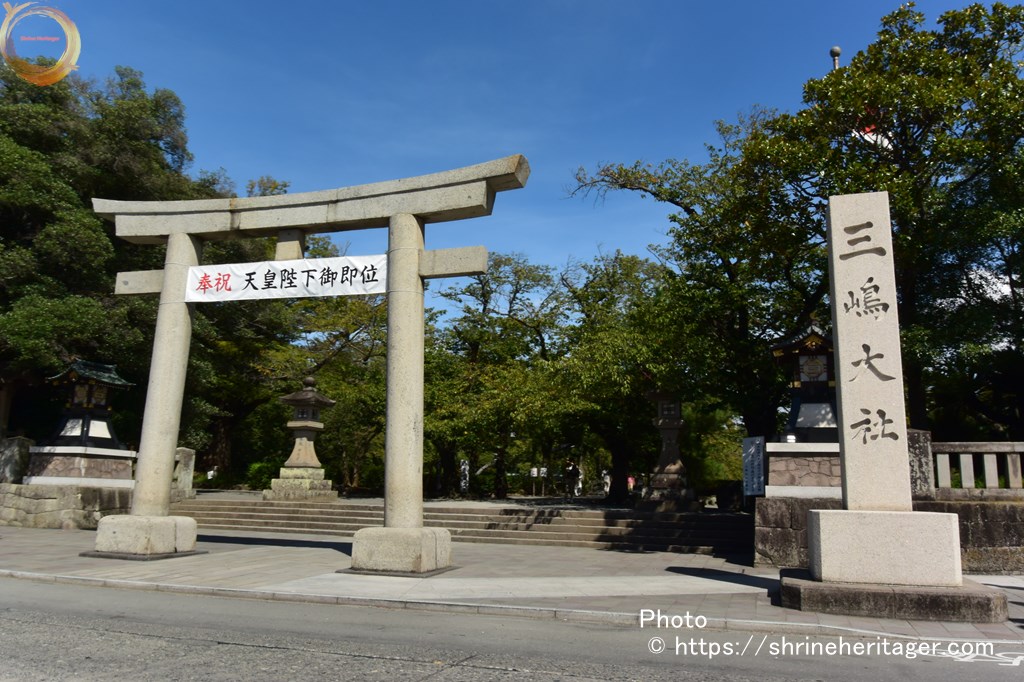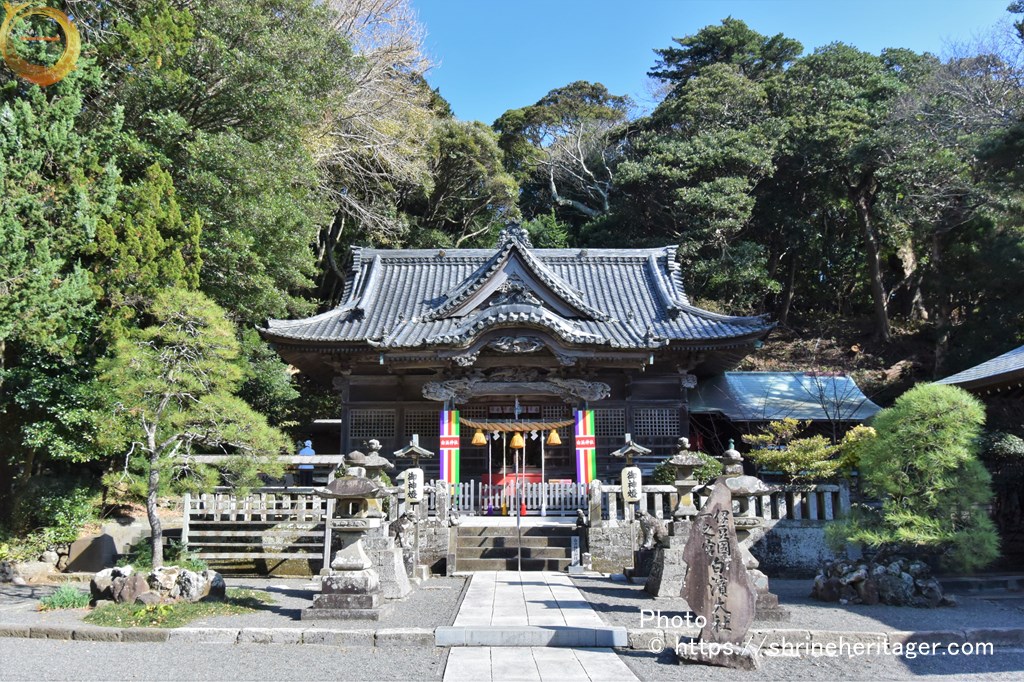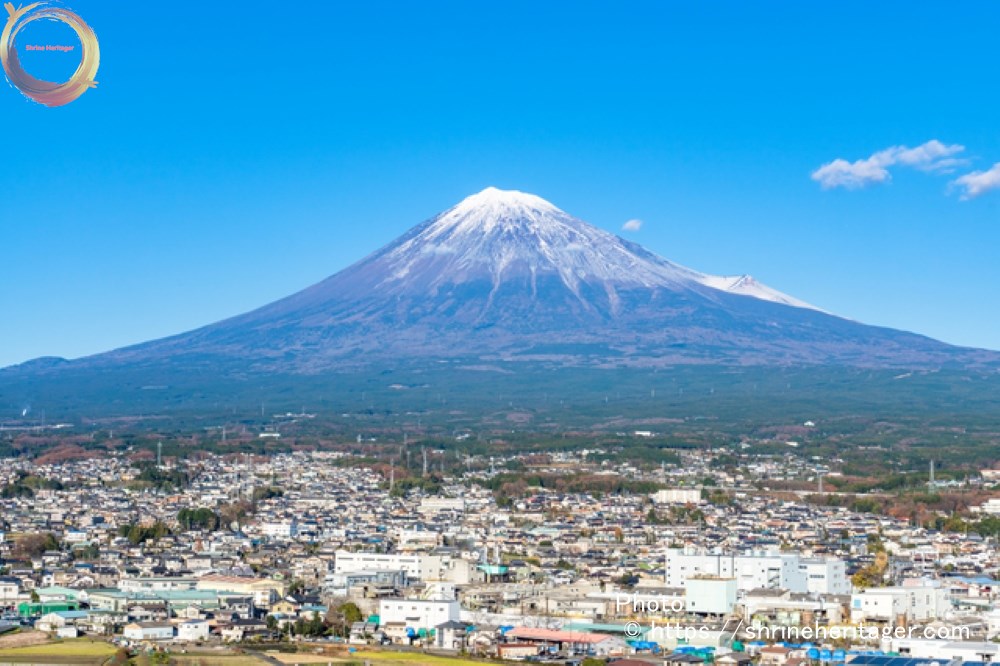Mishima Taisha had been revered by the Imperial Court as a god responsible for the eruption and island activities of the Izu Islands for a long time. Since he went to pray in the hope of starting and established the Samurai government in 1180, it became a shrine of the shogunate reverence through the Kamakura period, and it is still the center of the belief of izu peninsula as Izu Kuni Ichinomiya.
目次
- 1 1.ご紹介(Introduction)
- 2 この神社の予備知識(Preliminary knowledge of this shrine)
- 2.1 【延喜式神名帳】(engishiki jimmeicho)The shrine record was completed in December 927 AD.
- 2.2 【オタッキーポイント】(Points selected by Japanese Otaku)
あなたが この神社に興味が湧くような予備知識をオタク視点でご紹介します
- 2.2.1 It is five companies that were considered to be the outer setsha of Mishima Taisha, and it is considered to be the company of "Engishiki Jimmeicho".
- 2.2.1.1 (1) "Asama Shrine"(Ninomiya, Izu Province) Zhenzachi: Shibamoto-cho, Mishima 6-3
- 2.2.1.2 ➁ "Yangbara Shrine"(Sannomiya, Izu province) Jinzachi: 4-7 Kitada-cho, Mishima City
- 2.2.1.3 ➂ "Hirose Shrine"(Izukuni Shinomiya) Jinzachi: Mishima City Ichimachi 19 (Rakujuen)
- 2.2.1.4 (4) "Uuchi Shrine" (God of The Gate) Jinzachi: Umena 1, Mishima City
- 2.2.1.5 ➄ "Sauchi Shrine" (God of The Gate) Jinzachi: Mishima Nakajima-ji Nishi 310-2
- 2.2.2 About "Harahedo shrine" (The end shrine that enshrines the god of the four pillars of The Temple on the west side of the precincts)
- 2.2.1 It is five companies that were considered to be the outer setsha of Mishima Taisha, and it is considered to be the company of "Engishiki Jimmeicho".
- 3 Visit the Shrine (Pray at the Shrine)
- 4 神社の伝承(Old tales handed down to shrines)
- 4.1 "Nihonn koki" Ismon 9 (832) May 癸 (22nd) Article on the company site
- 4.2 Tradition remaining in Tomito Mishima Shrine (Former Mijima Shrine)
- 4.3 "Tsuku Nihon Koku Kokuki" (840)
- 4.4 It enters the Middle Ages from ancient times, and it is written as a document that can confirm the present seat in 1180 in the 4th year (1180) of "Azuma kagami"
- 4.4.1 "Azumakagami" 4th year (1180) "Minamoto Yoritomo's raising" written in the August 17 article (it is an important day that can be said to be a turning point to the samurai government in Japanese history)
- 4.4.2 "Azuma Kagami" Bunji 4th year (1188) The first "nisho mode" written in the article of the New Year's Day 20
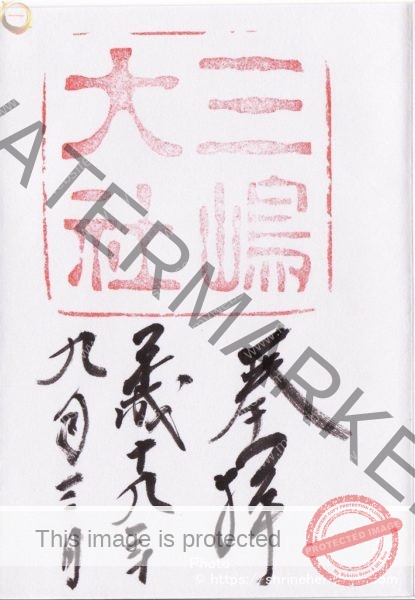
1.ご紹介(Introduction)
The official name of this shrine and how to be called The present address and map I will introduce the history of the god and the shrine enshrined.
【神社名(shrine name)】
三嶋大社(mishima taisha)
(みしまたいしゃ)
[通称名(Common name)]
Taisha (taisha) and Myojin (myojin sun)
【鎮座地 (location) 】
2-1-5 Omiya, Mishima, Shizuoka Prefecture
[地 図 (Google Map)]
【御祭神 (God's name to pray)】
The god of the two pillars is generally referred to as "mishima Daimyojin".
《主》大山祇命(oyamatsumi no mikoto)
積羽八重事代主神(tsumihayae kotoshironushi no kami)
《配》阿波神(awa no kami)
伊古奈比咩命(ikonahime no mikoto)
楊原神(yakiwara no kami)
【御神格 (God's great power)】(ご利益)
Protect of Mountines, the guardian deity of Yamamori Agricultural, forests and agricultural products
・福徳の神 God of Fortune
・家内安全 Safe and comfortable home life
・商売繁盛 Wishing business prosperity
・交通安全 Pray for Traffic safety
・安産 Healthy childbirth
・初宮詣 Baby prays at shrine for the first time
・七五三詣 7 year old 5 year old 3 year old celebration
・厄除け Prayer at an age considered a milestone in life
・開運 Good luck
・病気平癒 God cures the disease
・合格祈願 Prayer for passing the exam
・良縁祈願 A desire to deepen connections and intimacy with good people
・その他 etc
【格 式 (Rules of dignity) 】
・『延喜式神名帳(engishiki jimmeicho)』所載社 名神大月次新嘗
・ 伊豆国一之宮(izunokuni ichinomiya)
・ 別表神社
・ 伊豆国総社
【創 建 (Beginning of history)】
The foundation is unknown.
"Engishiki Jimmeicho"(compiled in December 1927) states that izu kunigamo-gun (southern Izu Peninsula, Izu Islands) is located.
The present zaza was affiliated with Tabata-gun at that time, so it is different from the description.
Then, various theories are proposed, and the Senza theory has become a popular theory.
At first, it is a theory that it was transferred to Izu Kokufu (current shrine) in Okawa-go, Tabata-gun in addition to Kamo-gun Mishima-go (The Island of Izu Islands) and To Taisha-go Shirahama (now Shirahama Shrine Ikonabi-咩-mei Shrine) and to Izu Kokufu (current shrine area) in Ogawa-go, Tabata-gun.
The current place of the zaza can be confirmed from an article in the 4th year (1180) of "Azuma Kagami"
【由 緒 (history)】
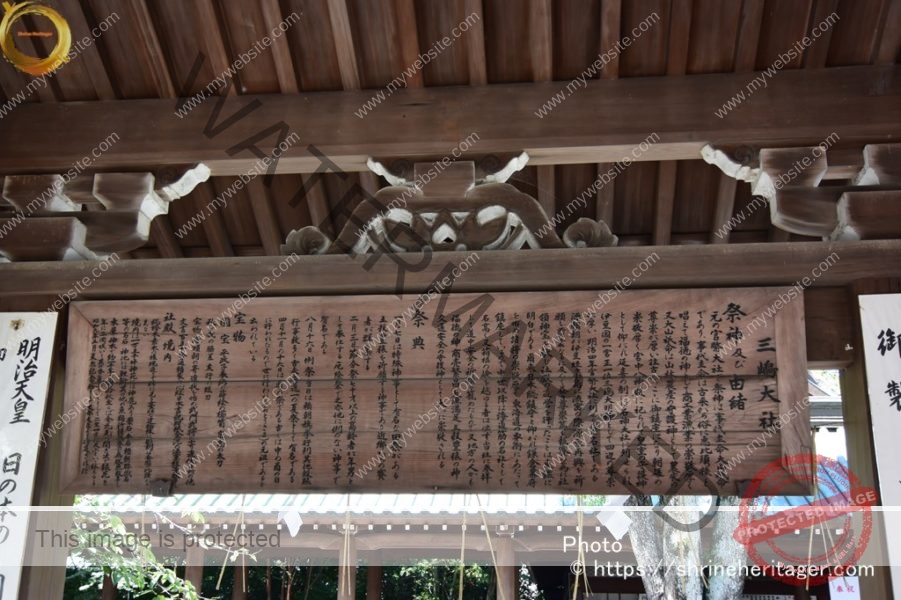
Mishima Taisha
Festival God Oyama Gionjin and The Lord's God
Oyama Gionjin is the god of the mountain, and it is a god of the industrial industry and the god of the national land development management for the start of the forest agriculture.
The head god of the war is commonly referred to as Ebisu-sama, and it is a god of commerce, industry, fisheries, and Fukutoku amicable.The foundation was very old in the former government mint taisha, and it sat in this place, and it became the place name of Mishima in the name of God.
In the system of Enki, it was lined up to Myojin University, which is already the highest case, and it was deposited in the official mint of the monthly and New Year's shrine, and 2000 bundles of the festival fee rice were received.
Since the Middle Ages, the samurai have been revered, especially Minamoto Yoritomo, on August 17, 1944, when he volunteered deeply to raise his flag, and as soon as he succeeded, he built the shrine hall, dedicated the sacred treasure, and revered it more and more.
Since then, he has gathered the reverence of the common people, including warlords of Takemon, and the name of Mishima Daimeijin has become widely known to the whole country.
In 1868, it was listed in the highest-established Kanmin Taisha Shrine, but the post-war government-mint system was abolished.Annual Festival It is called a big festival in three days of 15th, 16th and 17th, mainly on August 16.
In addition, the festival is held 115 degrees a year.
Treasures Including the National Treasure Umemaki-e Te Box (Hira Masako Dedication), Shigefumi Mune Tadakazu, Shigefumi Akiyoshi Shitasashi, Shigemi Mitsushima Today's Book No, other old documents such as Yoritomo, Yoriie, Ando, Kenke, Sozui (Hayaun), etc. are stored.The shrine hall and the precincts have been built several dozen times since ancient times, but the present shrine building is 11 years in 11 years of Kaei (the god of Mishima-Ogami)
It was completed in Keio 2 years by the priest Yadabe Shikibe Moriharu who collapsed due to the Tokai earthquake on April 4, investing a huge cost of more than 16,677 cars with 10 years.
After that, some repairs were carried out by the Great Kanto Earthquake and the Izu Earthquake.
The precincts are about 15,000 tsubo (50,000 square meters)."National Shrine Festival Comprehensive Survey (1995)" [Shrine Head Office]
【境内社 (Other deities within the precincts)】
Wakamiya Shrine (Wakamiya shrine)(Setsha that enshrines the deity god of the debored Namei Shrine of The God of The God of Mishima Ogami, The God of The Shrine of The Shrine of The Shrine of The Shrine of The Shrine of The God of The Great God of Mishima University)
《主》物忌奈乃命(monoimina no mikoto)
誉田別命(homutawake no mikoto)(第15代 応神天皇)
神功皇后(jingu kogo)
妃大神(hime no okami)
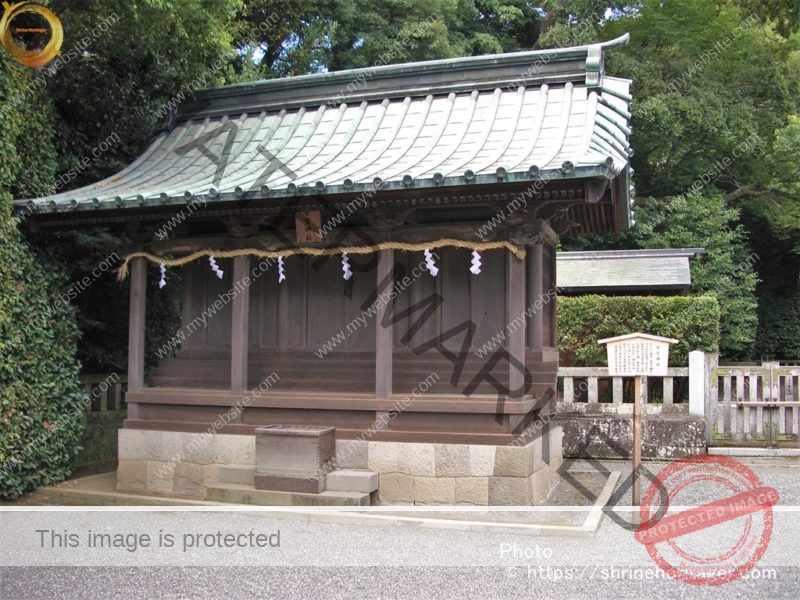
・見目神社(mirume shrine)(三嶋大神の伊豆諸島の妃神六柱を祀る摂社)
《主》波布比売命(伊豆大島の妃神)
久爾都比咩命(新島の妃神)
伊賀牟比咩命(三宅島の妃神)
佐伎多麻比咩命(三宅島の妃神)
伊波乃比咩命(三宅島の妃神)
優波夷命(八丈島の妃神)
東五社 (内庭 舞殿の東方に鎮座し次の5社を祀る末社)
・大楠社《主》大楠神
・天神社《主》瓊瓊杵尊
・聖神社《主》聖神
・第三社《主》第三王子
・幸神社《主》猿田彦神
西五社 (内庭 舞殿の西方に鎮座し次の5社を祀る末社)
・小楠社《主》小楠神
・第二社《主》第二王子
・酒神社《主》豊受比売神
・飯神社《主》保食神
・船寄社《主》塩土老翁
・祓戸神社(harahedo shrine)(境内西側に鎮座 祓戸四柱の神を祀る末社)
《主》織津姫神(seoritsuhime no kami)
速秋津姫神(hayaakitsuhime no kami)
気吹戸主神(ibukidonushi no kami)
速佐須良姫神(hayasasuraihime no kami)
桜川が流れ込む池の中の島に鎮座 国司によってこの地に奉斎され 国司の大社参拝の際は必ず当地で祓いを行なったと云う
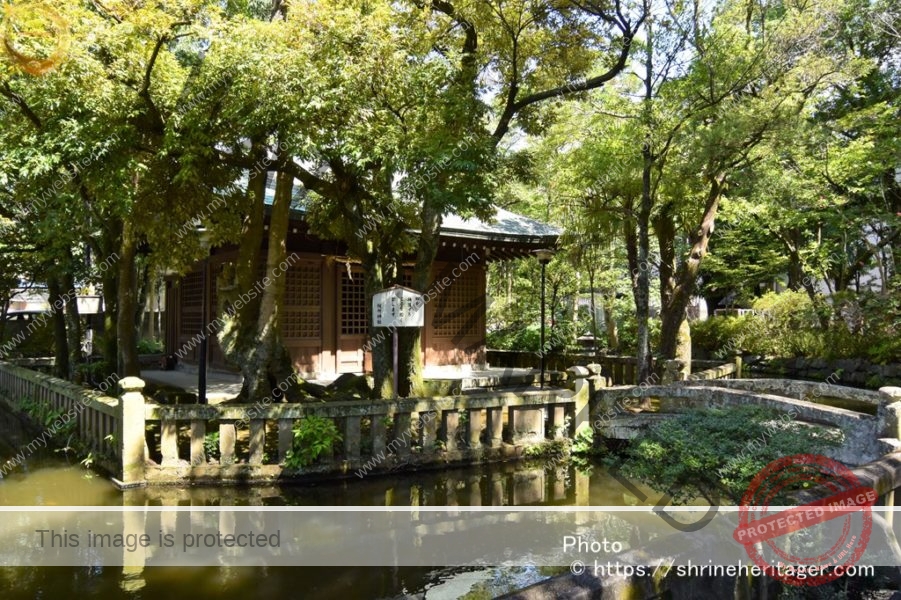
・厳島神社(itsukushima shrine)(境内 神池中の島に鎮座 北条政子の勧請)
《主》市杵島姫命(ichikishimahime no mikoto)
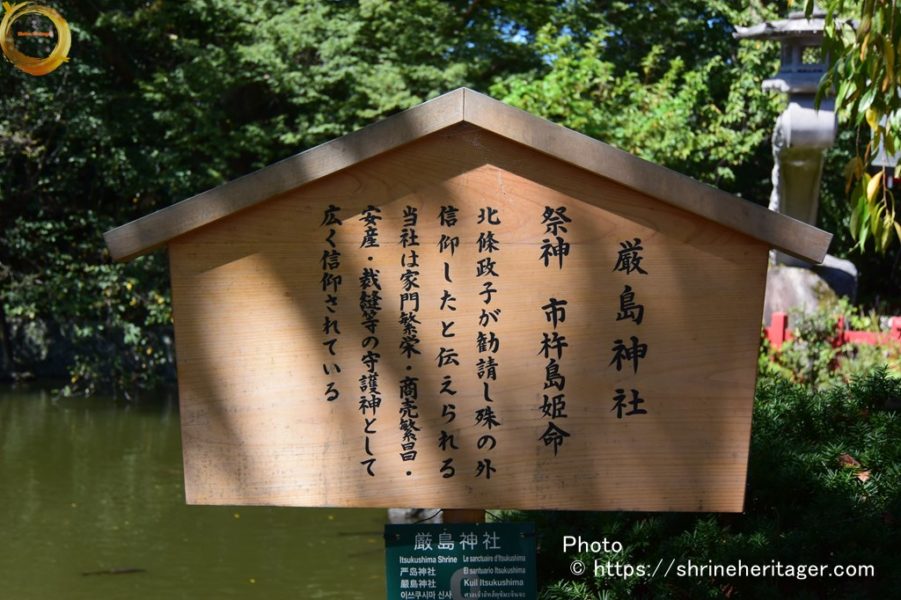
・伊豆魂神社 (伊豆一円の戦没英霊二三七二柱を祀る境内末社)
《主》護国の英霊
・淡嶋神碑《主》淡島神
スポンサーリンク
この神社の予備知識(Preliminary knowledge of this shrine)
This shrine has a long history.
『延喜式神名帳(engishiki jimmeicho)』The two volumes that are regarded as important among all 50 ritual- style scrolls created by the Imperial Court during the middle Heian period are called " engishiki jimmeicho " (edited in December 927). Approximately 1100 years ago, the name of "2861 company" and the number of gods enshrined there are listed in the list of government offices (shikinaisha) nationwide.
【延喜式神名帳】(engishiki jimmeicho)The shrine record was completed in December 927 AD.
[旧 行政区分](Old administrative district)
(神様の鎮座数)東海道 731座…大52(うち預月次新嘗19)・小679
[旧 国 名 ](old county name)
(神様の鎮座数)伊豆国 92座(大5座・小87座)
[旧 郡 名 ](old region name)
(神様の鎮座数)賀茂郡 46座(大4座・小44座)
[名神大 大 小]Ceremony Meishin Taisha 式内 名神大社
[旧 神社名 ] 伊豆三島神社(名神大月次新嘗)
[ふ り が な ](いずみしまの かみのやしろ)
[How to read] (izumishima no kamino yashiro)
https://www.digital.archives.go.jp/DAS/meta/listPhoto?LANG=default&BID=F1000000000000004146&ID=M2014101719562090086&TYPE=&NO= Image Use
National Diet Library Digital Collection Enki-shiki Publication (Baba) [Former Kurashi] Autumn Leaves Yama Bunko
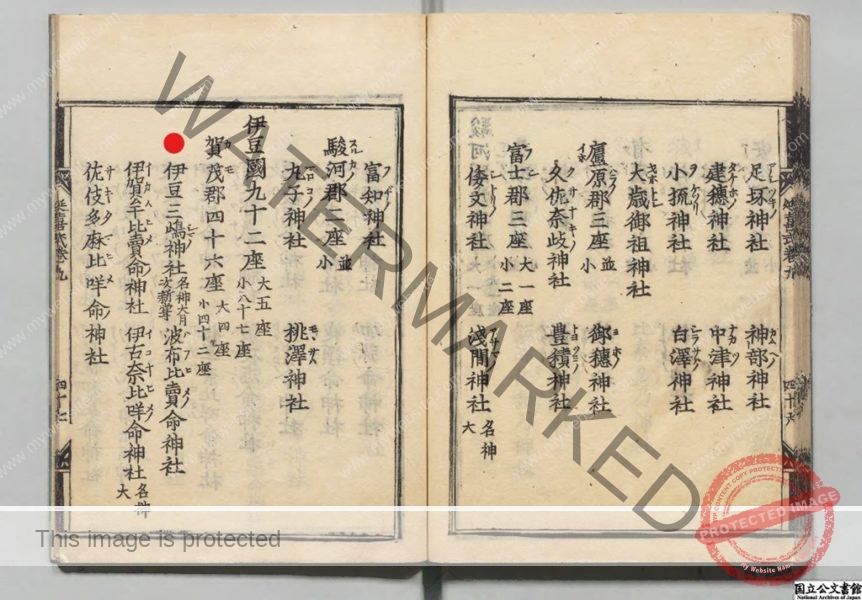
【オタッキーポイント】(Points selected by Japanese Otaku)
あなたが この神社に興味が湧くような予備知識をオタク視点でご紹介します
It is five companies that were considered to be the outer setsha of Mishima Taisha, and it is considered to be the company of "Engishiki Jimmeicho".
Izu Province is one of the rule-of-law countries that used to be a local administrative division of Japan, and in modern administrative divisions, "Shizuoka Prefecture Izu Peninsula" & "Tokyo Izu Islands" become the equivalent area Mishima Taisha was "Izu Kuni Ichinomiya", and Ninomiya, Sannomiya, and Shinomiya were setsha outside the border.
(1) "Asama Shrine"(Ninomiya, Izu Province) Zhenzachi: Shibamoto-cho, Mishima 6-3
(Izu Kunigamo-gun, Iga-mu-Himei Shrine)
➁ "Yangbara Shrine"(Sannomiya, Izu province) Jinzachi: 4-7 Kitada-cho, Mishima City
(Izu Kunidata-gun, Yangbara Shrine, Meishin University) "Engishiki" Ronsha
➂ "Hirose Shrine"(Izukuni Shinomiya) Jinzachi: Mishima City Ichimachi 19 (Rakujuen)
(Hirose Shrine, Izu Kunidata-gun)
(4) "Uuchi Shrine" (God of The Gate) Jinzachi: Umena 1, Mishima City
(Izu Kunitakata-gun, Ametose KitaChimei Shrine) "Engishiki"
(Izu Kunigamo-gun, Iami-氐Betsumei Shrine)
➄ "Sauchi Shrine" (God of The Gate) Jinzachi: Mishima Nakajima-ji Nishi 310-2
(Bunri Shrine, Izu Kunidata-gun)
(Izu Kunitakata-gun, Ametose KitaChimei Shrine) "Engishiki"
About "Harahedo shrine" (The end shrine that enshrines the god of the four pillars of The Temple on the west side of the precincts)
It is a mysterious shrine of the formality that "It was a priesting here without fail at the time of the taisha visit of the kokuji" which is dedicated to this place on the island in the pond where the Cherry River of the subsoil water of Mt. Fuji flows, and it is thought that it was enshrined before Mishima Daisha moved to here separately from the taisha.
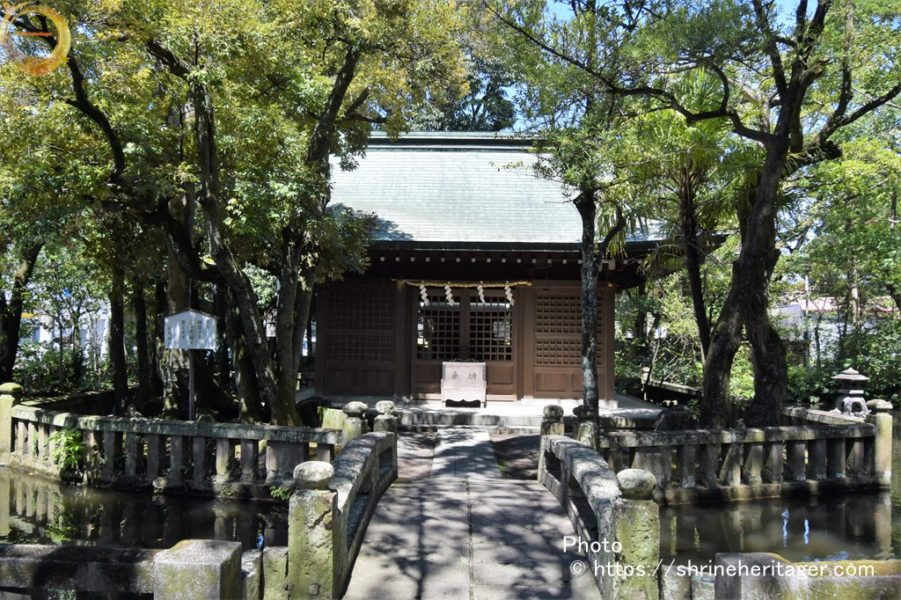
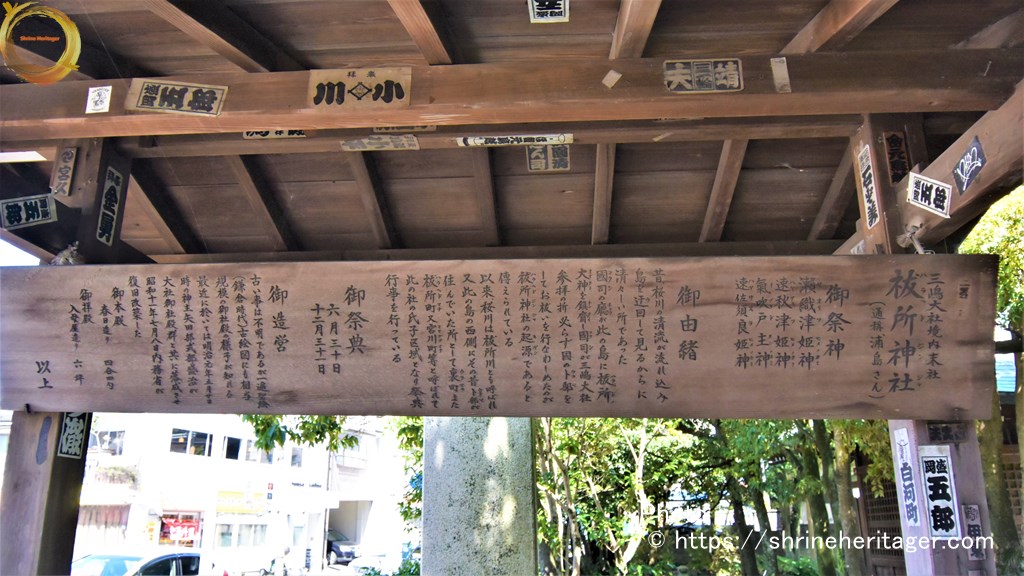
Mishima Taisha Precinct End Shrine
Exorcism Shrine (Harahedo Jinja) (also known as Urashima-san)
Festival God Oriz Himegami (Seoritsu Himenokami)
Hayaakitsu Himegami (Hayaakitsuhimenokami)
Kibukido Lord God (Ibukidoninokami)
Hayasa Sura Himegami (Hayasasrehimenokami)Goyu
Once upon a time, the clear stream of Sakuragawa flowed in and it was a refreshing place to look around the island.
The 廰 (chow) of the Kokushi (Kokushi) enshrines the Exorcism (Harahedono wolf) on this island.
It is said that it is the origin of The Shrine (Harahedojinja) that Kuniji (Kokushi) did the Bokbe (Urabe) of the country and performed the exorcism at the time of the visit to Mishima Taisha.
Since then, Sakuragawa has also been called the Exorcism River, and on the west side of this island, it is called Uramachi (Uramachi) and Otorisho-cho (Harahedomachi) and Miyagawa-cho (Miyagawamachi) etc. as the place where the Bokbe (Urabe) lived in the old days, and it becomes the ujiko area of this company and is holding a festival event.Festival
June 30
December 31Gozo-ei
It is unknown that the old thing is, but the state of your company of a considerable scale is known in the old picture of Ichihen Seie (Kamakura period)
Recently, on May 1988, the priest, Yadabe Shikibe Moriharu, was completed with the Taisha company and the shrine, and the Ministry of the Interior restored and renovated on July 8, 1946.Gomotoden Kasuga-zukuri Four-way four-tsubo
Gokaiden Irimaya-zukuri RokutsuboFrom the guide board of the precincts
スポンサーリンク
Visit the Shrine (Pray at the Shrine)
I introduce the state when I visited this shrine.
About 1.1km from Mishima Station via Prefectural
Road No. 51 about 15 minutes on foot The place facing the old Tokaido Sits at the starting point of Shimoda Highway as the gateway to Izu.
Arrived at Mishima Taisha
A large torii gate and the company's name "Mishima Taisha" are built at the head of the company.
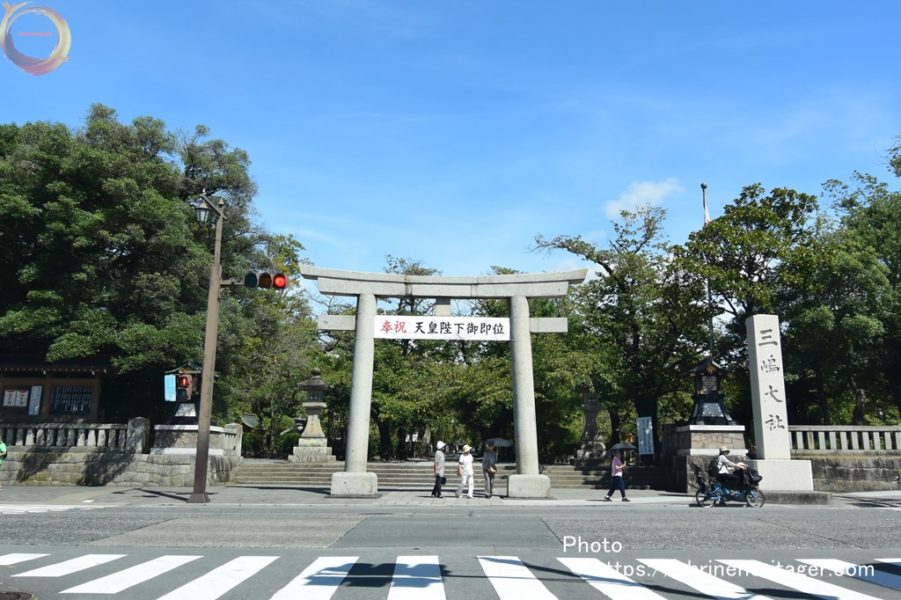
Bow through the torii gate of the head of the company.
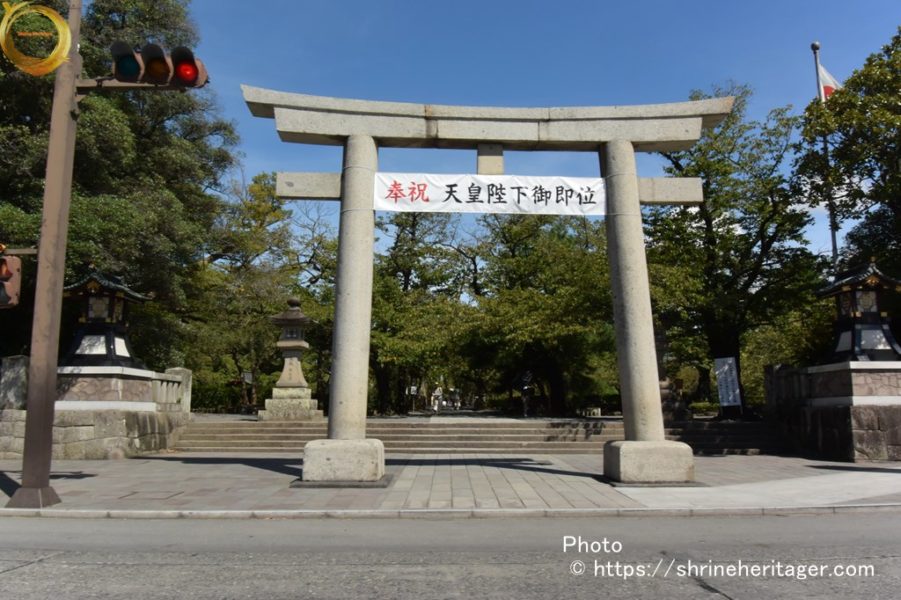
There is a stone on the
right hand side. It's a bit scary name,
but I feel relieved when I read the guide board. "Tangled 垜 is a tool to prevent the tangle of yarn, and the meaning word of the arrangement the stone which was placed at the intersection of the old Tokaido and arranged the person who came and went.
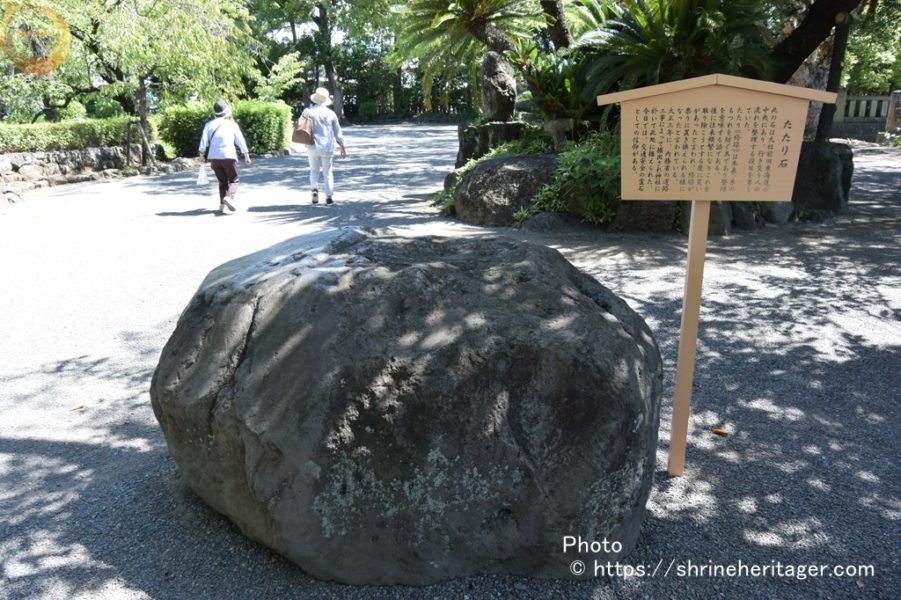
The approach extends straight through the kamiike pond, and it is a large, large precinct.
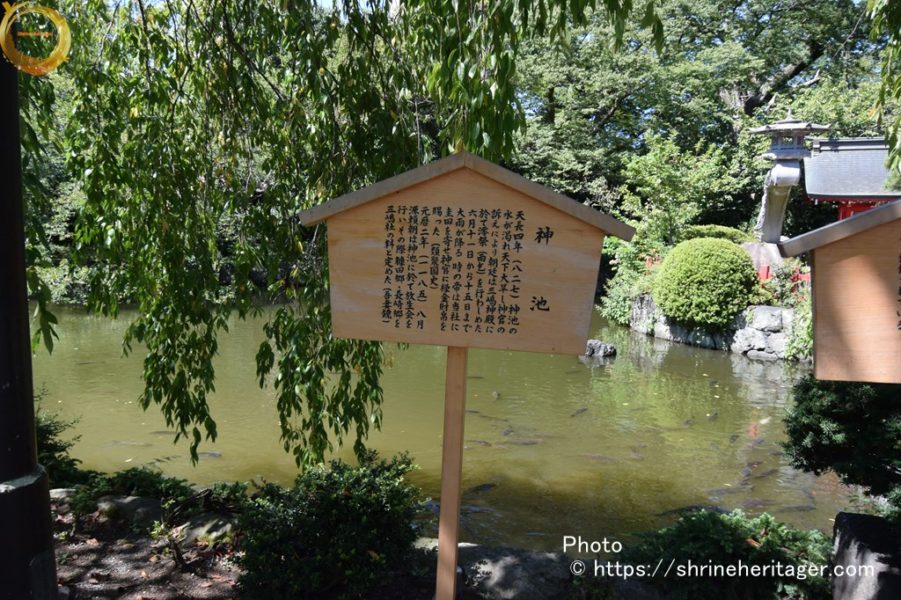
I visit the precinct shrine which is said to be a recommendation of Masako Hojo on the island in the shinto pond of the approach.
・ Itsukushima Shrine (itsukushima shrine)
"Lord" Ichikijima Himemei (ichikishiminami no mikoto)

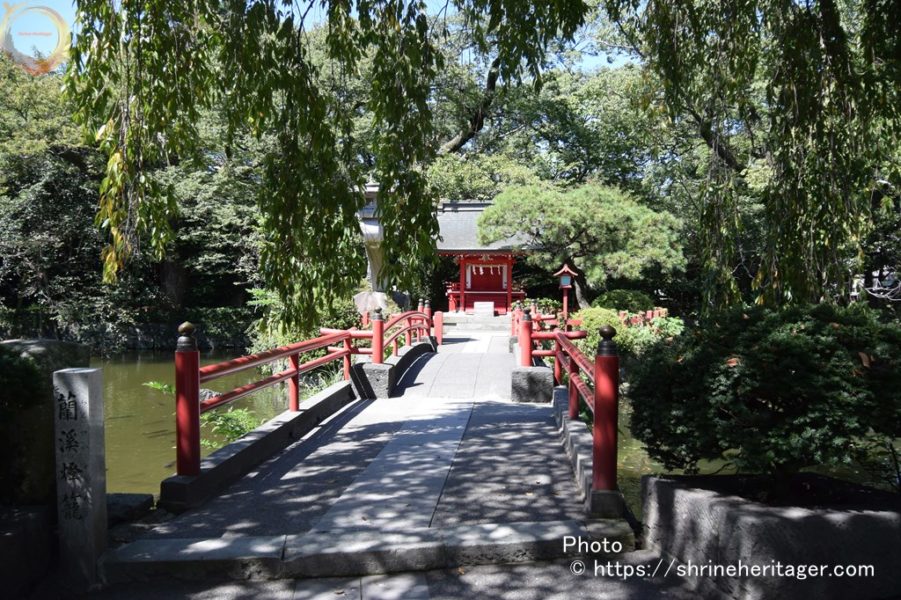
Next, the "main gate" is built, and it goes through with a bow.
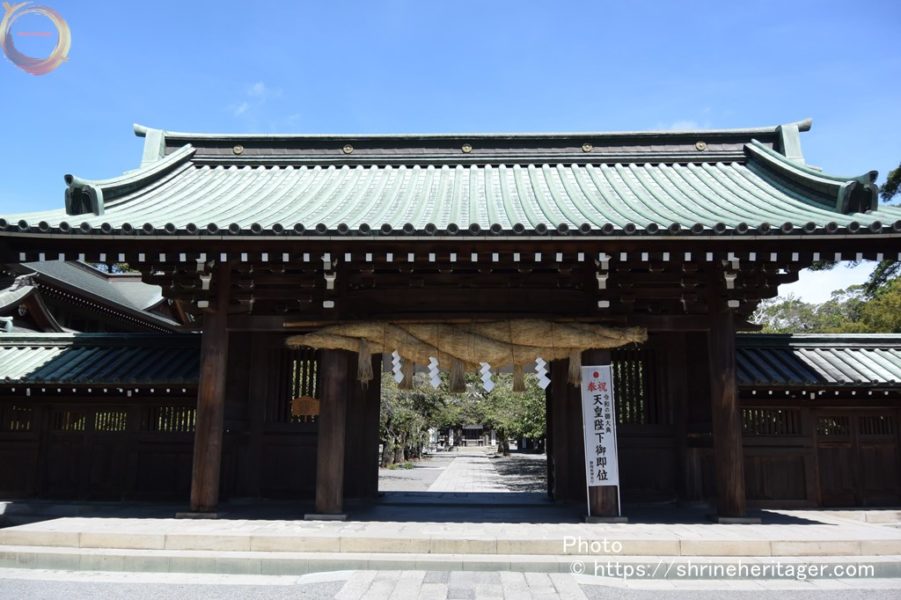
In addition, we walked along the approach of a row of cherry trees.
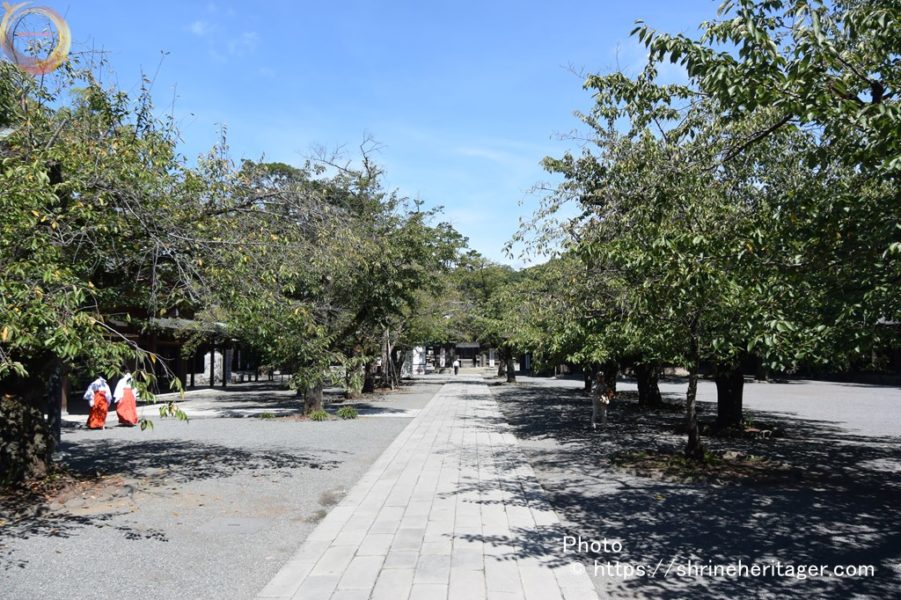
"Shinmon" is built, and it goes through with a bow.

In the center of the precincts, there is a "dance hall" built.
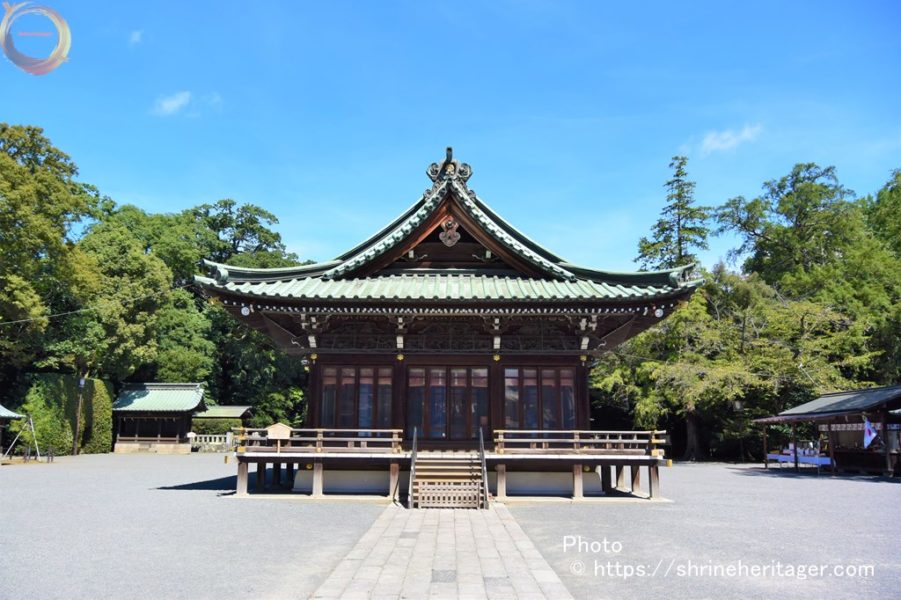
You can see the shrine hall behind "Maiden".
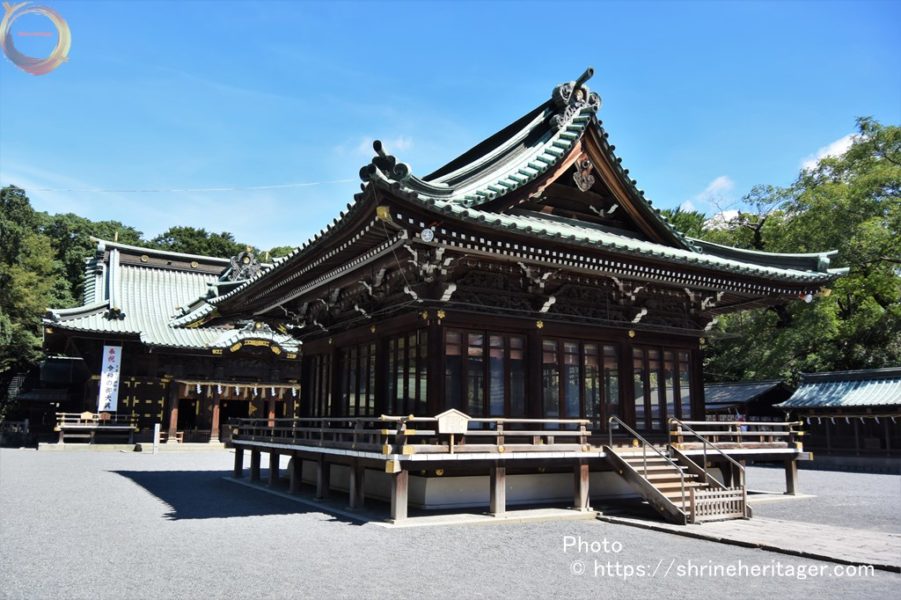
I'm going to go to the shrine.
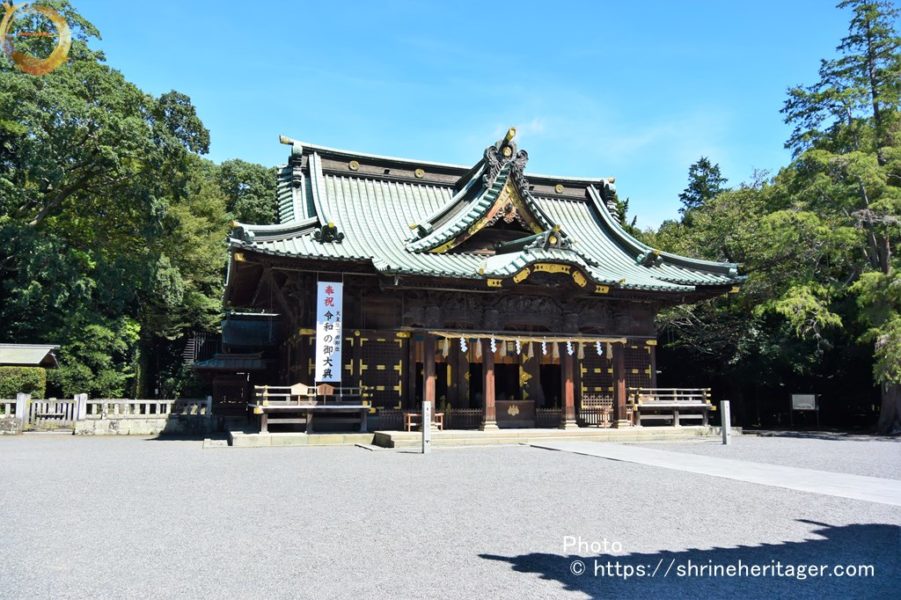
Give me a prayer.
When you reach the god of worship, where you worship God's power, pray with your hands together.
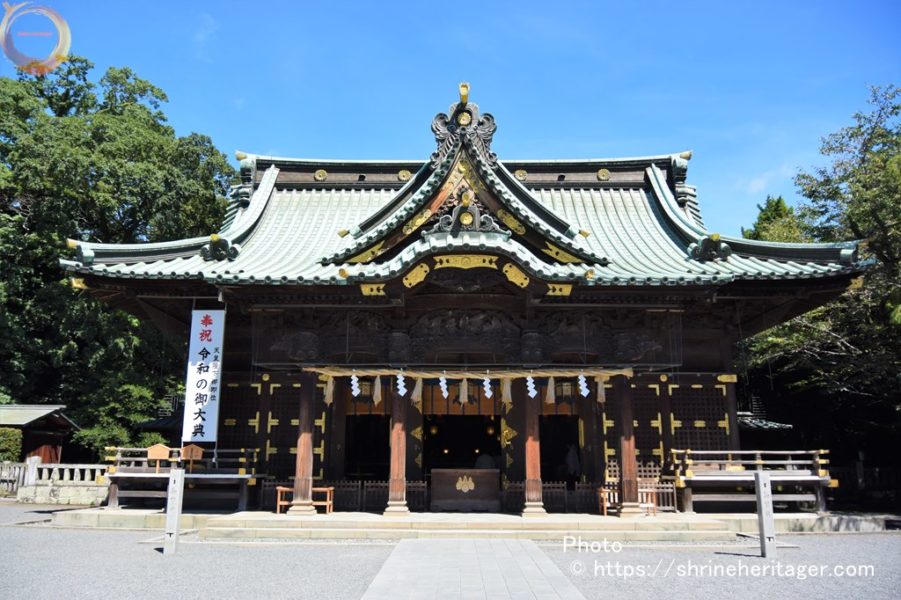
On the left side towards the shrine hall, the shrine sits in the precincts and visits.

Left side immediately towards the shrine
Wakamiya Shrine (Wakamiya shrine)(Setsha that enshrines the deity god of the debored Namei Shrine of The God of The God of Mishima Ogami, The God of The Shrine of The Shrine of The Shrine of The Shrine of The Shrine of The God of The Great God of Mishima University)
"Lord" Nana no Life (monoimina no mikoto)
Homutake no mikoto(15th Emperor Ogami)
Empress Jingu kogo
Hime no okami
On the left side towards The Maiden
Mirume shrine (Setsha dedicated to the six pillars of the Princess of the Izu Islands of Mishima Ogami)
"Lord" Hafu Hieimei (The Queen of Izu Oshima)
The Life 咩 Kujito (The Queen of Niijima)
Iga-muhi咩 Life (The Queen of Miyakejima)
The Life 咩 The Life of The Princess of Miyakejima
The Life of 咩 Inami (The Queen of Miyakejima)
Yunami Imei (The Queen of Hachijo Island)
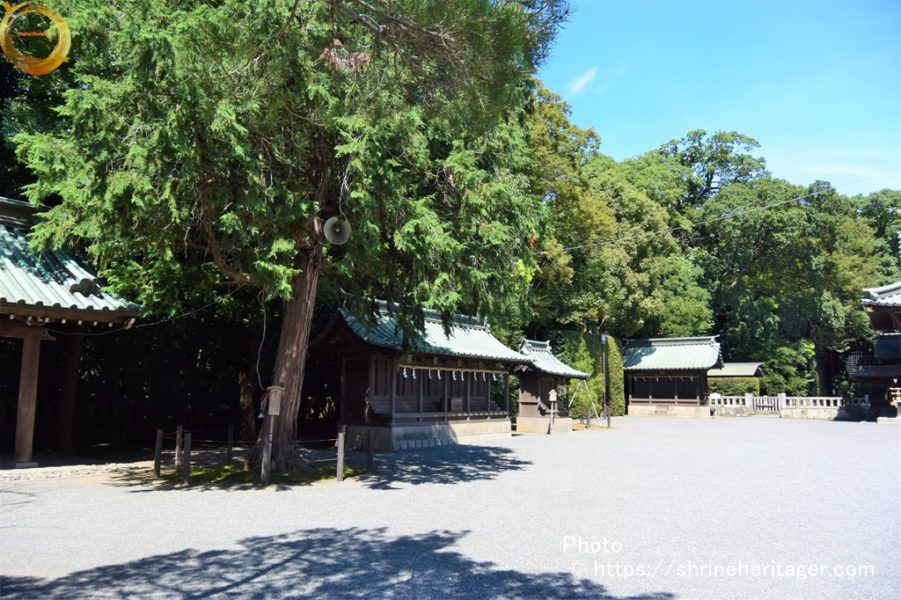
On the right side towards The Maiden, there is a god tag awarding place where you can award amulets, seals, etc.

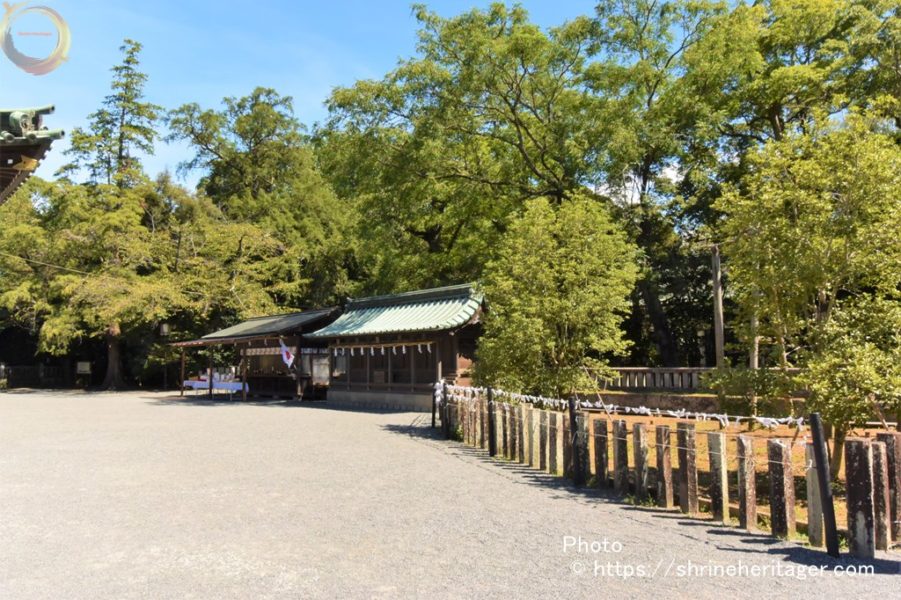
I'll leave the precincts and return to the Shrine Gate.
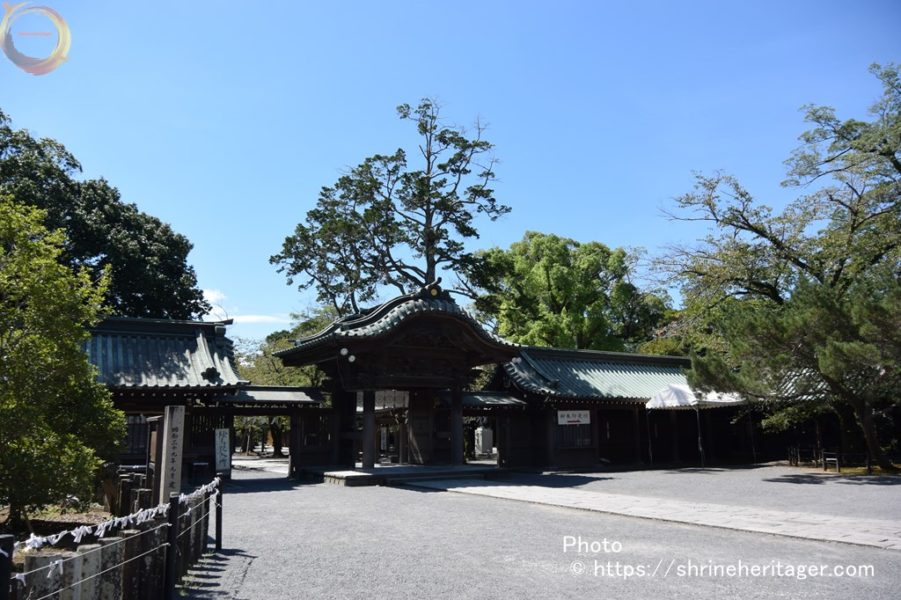
We'll go back the approach, go through the main gate, look back, and bow.
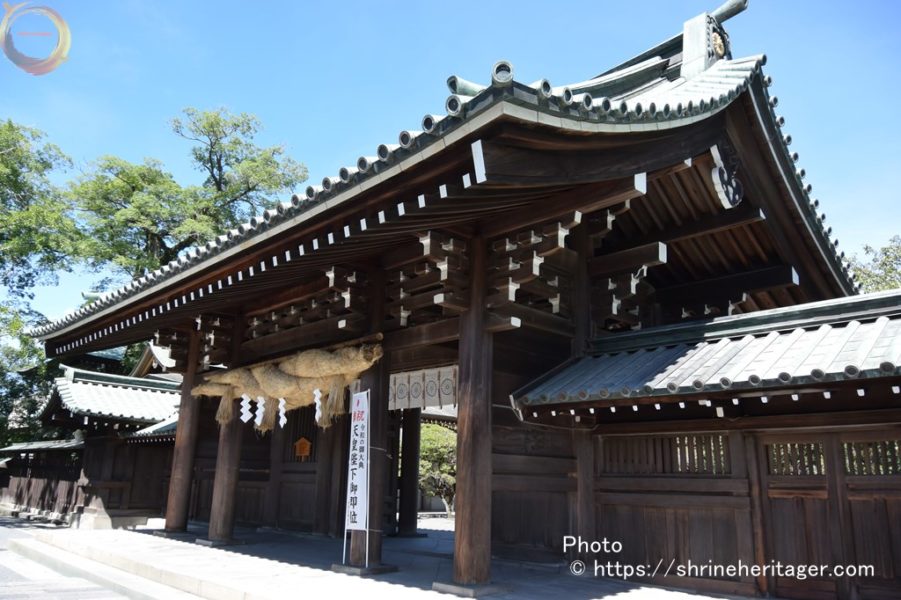
If you go west from the main gate instead of the direction of kamiike a little while ago, you will see "Harahedo Shrine" of the precincts.
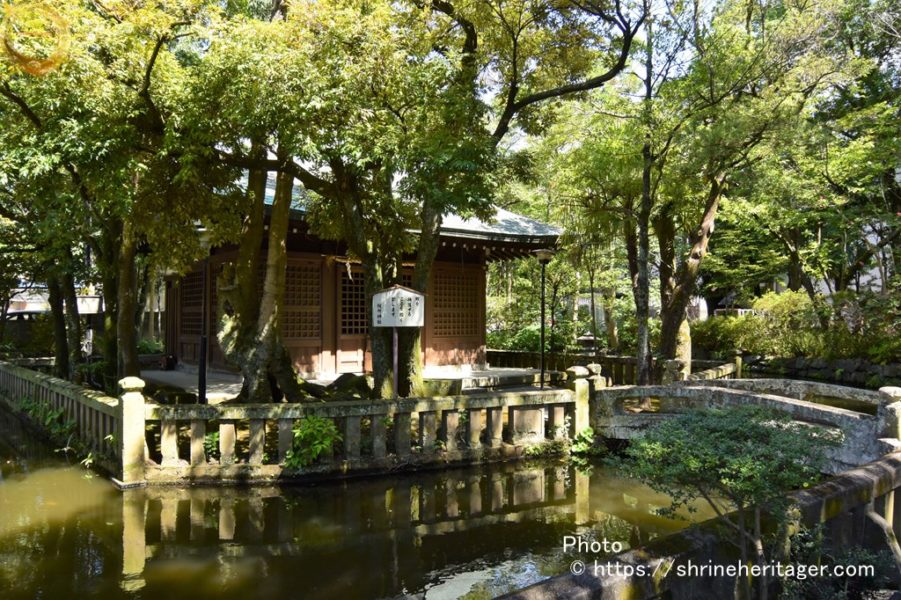
As I mentioned earlier, I'll leave out the details, but originally, it would be the right way to visit here, so there's also a temizusha.
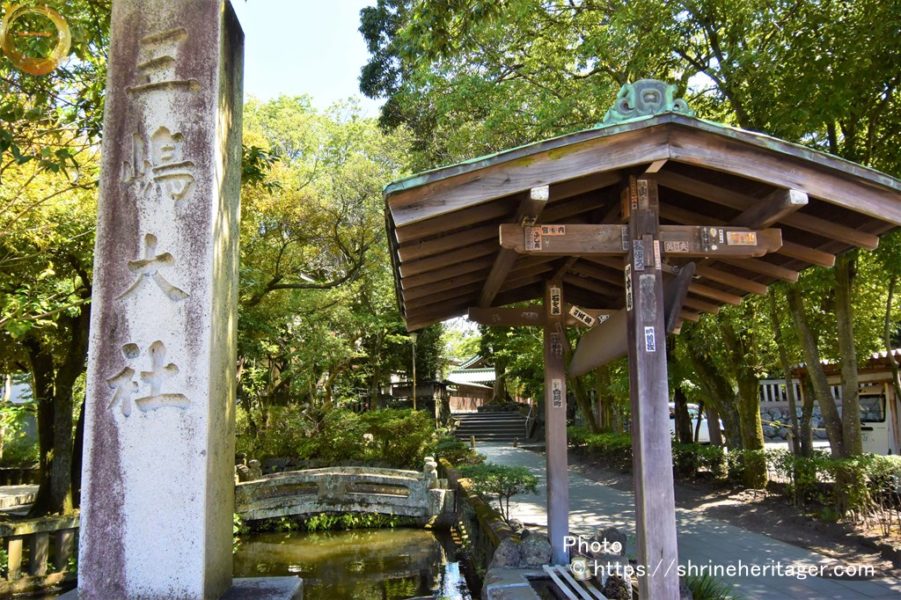
スポンサーリンク
神社の伝承(Old tales handed down to shrines)
I introduce the thing related to this shrine and the literature described.
There is a theory that Mishima no kami is the god of the Izu Islands called "mishima no kami" (awe-honored name
for the Izu Islands of people who were in awe of ancient eruptions) It is said that the old place of the zhenza was "Mishima".
"Nihonn koki" Ismon 9 (832) May 癸 (22nd) Article on the company site
"Nihon koboki" is a record of 792-833 (42 years) (10 existing volumes in the history of six countries)
Mishima Taisha is said to have originally been enshrined in Shirahama, Shimoda City, izu islands, and the description is considered to be a description at the time of Shirahama Jinza, so I take care of "Meishin" because it showed the god of god at this time.
Original text
"Izu Kunigen Kami Mishima-jin Ikonahi咩 God Nizen-minmeijin Fukai 摧 Takaganhei Zonoji 2,000-cho-ku Sakushinjinji-in Ike-Sanji Kami-Igano no Katsumae-sui-sui-sui"
Translation
"There was a word from Izu Province"
Take care of the two-way gods of Mishima-jin (Mishima Taisha) and Ikonahi-咩 -- (Shimoda Shirahama Shrine)
This god is in the 摧 high of the deep valley that was blocked.
The land of Hirazo is permitted 2,000 towns, and the shinto shrine "Niin" system and the pond are three places to build.
The thing that God is different is a non-victory meter.
Tradition remaining in Tomito Mishima Shrine (Former Mijima Shrine)
"Mishima no kami" of the festival god
Izu Nanashima Island was pioneered, and on the way to "Mishima Taisha" from "Shirahama Shrine" in Kamo-gun (now Shirahama, Kawazu-cho) to Mishima Taisha, Mishima-cho, Tabata-gun (now Mishima City, Shizuoka Prefecture)
The "futo" here was also bathed in God's virtues, so he said motomijima shrine (moto mishima shrine), but later changed it to Mishima Shrine.
For more information, please refer to the article "Tomito Mishima Shrine (Motomishima Shrine)"
"Tsuku Nihon Koku Kokuki" (840)
"Tsuku Nihon Koku Kokuki" 7th year (840) Tradition written on September 23
Summary
"Awa no kami" of Mishima-jin's main wife (honmi) in Kamitsushima (Kozushima) The "monoimina no mikoto" of the son god is enshrined.
On the night of July 5, 1938, a violent eruption occurred in Kamitsushima (Kozushima), but the result of the fortune-telling was that the guardian of The Mishima-jin (Ikonabi咩 Life- Shirahama Shrine) was given the rank (Kamishina) to the third floor.
It was considered to be due to anger over the fact that "Awa no kami" (Awa no kami) (Awa 咩 life: Awamei Shrine) of the hongo had been reported.意訳 Translation
"The main shrine of Mishima Taisha is "awa no kami" which sits in Uezushima (now Kozushima).
In addition, "monoimina no mikoto" is enshrined, but it is the god of "awa no kami".The newly built shrine is 4 in the hospital, the stone room is 2 between the 2, the dark room 13 units, Tsushima is Shigeshige Kusagi . . . . . . . . . . . . . . . . . . . . . . . . . . . . . . . . . . . . . . . . . . . . . . . . . . . . . . . . . . . . . . . . . . . . .
"Tsuku Nihon Koku Kokuki" 7th year (840) Tradition written on The 14th of October
Summary
In the article about one month after receiving the article of The Article of September 23 of 840
It is written that the sacred floors of "Awa no kami" and "monomina no mikoto" rose from the infix to the fifth place down.
[Reference] National Archives Digital Archives "Continued Nihongoki" (869) Sadakan 11 years completion Winner: Fujiwara Ryobo / School revision: Tateno Spring Festival Kanmoto Hiromasa 2007 [former brewer] Ministry of the Interior
https://www.digital.archives.go.jp/DAS/meta/listPhoto?LANG=default&BID=F1000000000000047680&ID=&TYPE=&NO=
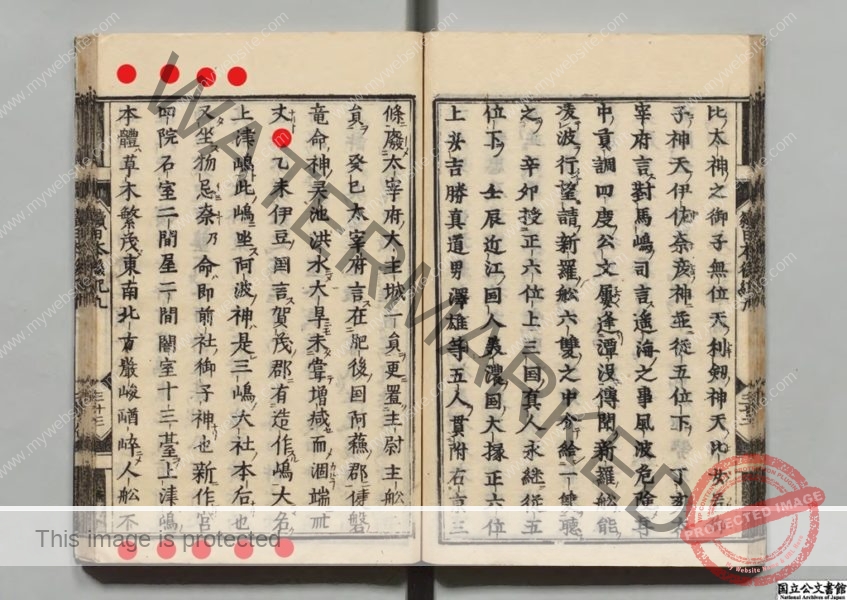
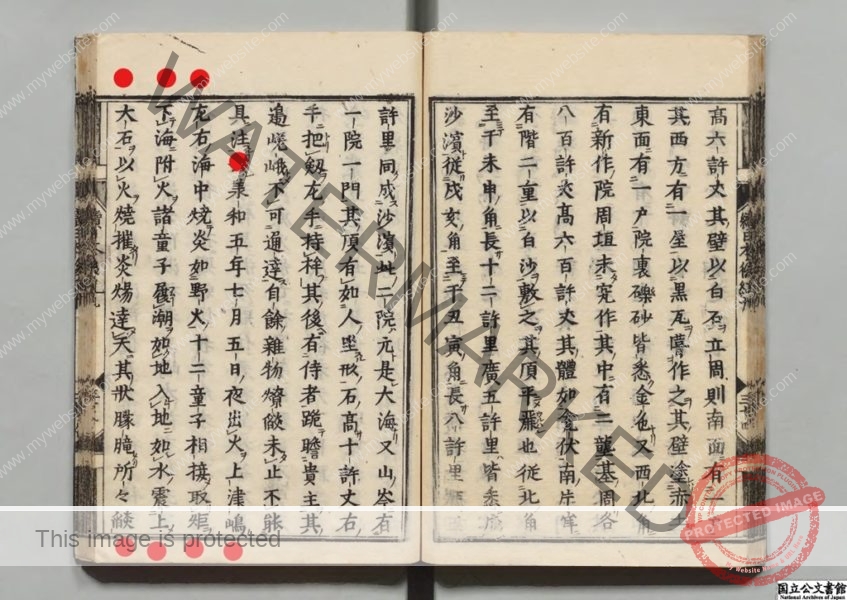
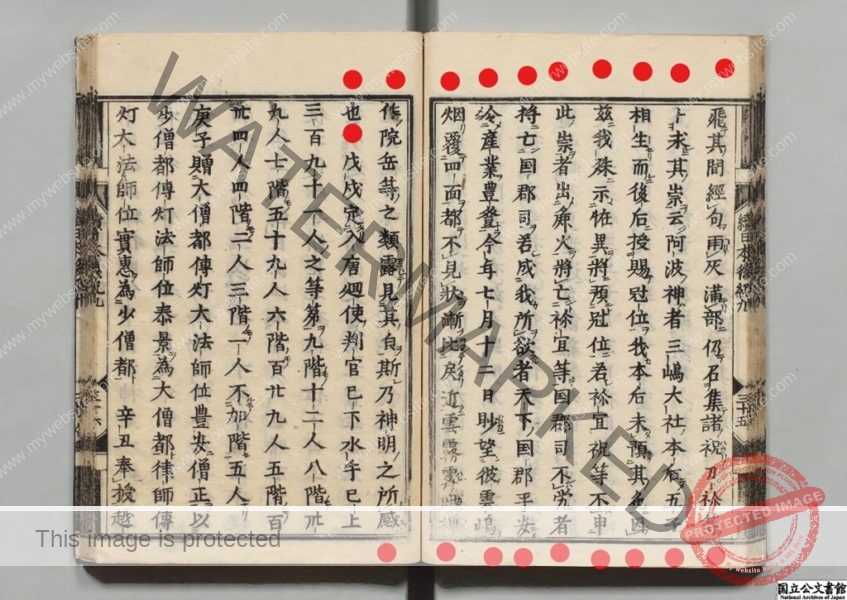
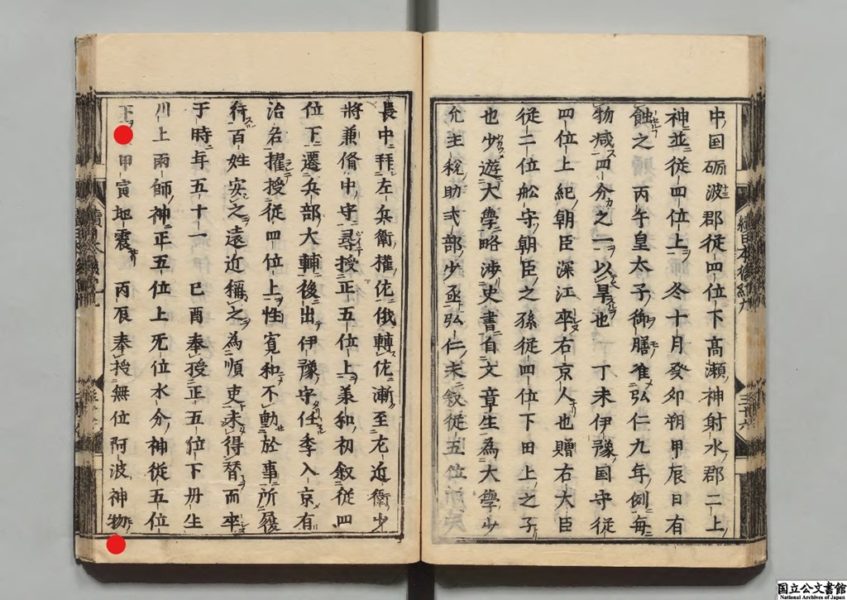
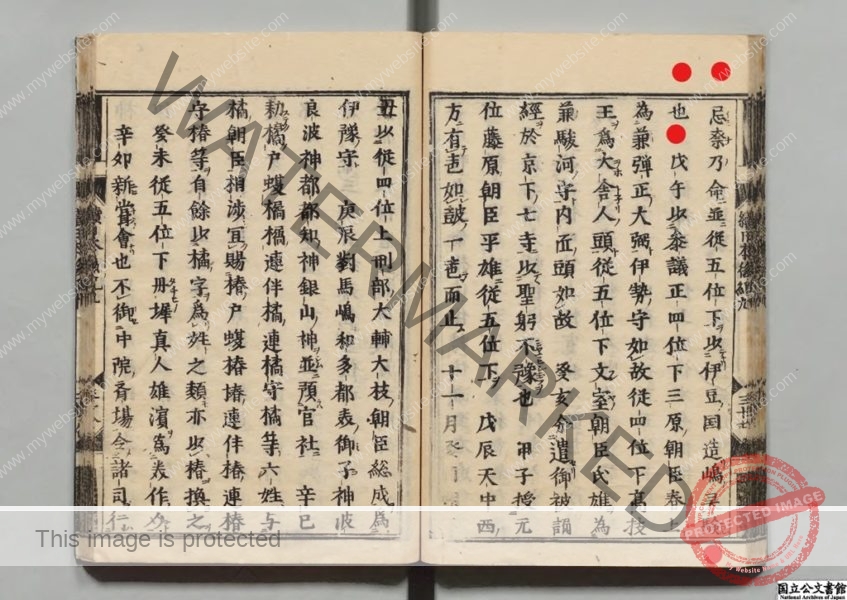
It enters the Middle Ages from ancient times, and it is written as a document that can confirm the present seat in 1180 in the 4th year (1180) of "Azuma kagami"
"Azumakagami" 4th year (1180) "Minamoto Yoritomo's raising" written in the August 17 article (it is an important day that can be said to be a turning point to the samurai government in Japanese history)
Summary
August 17 (current mid-September) Fine weather It becomes the Shinto ritual of Mishima Taisha
On this day, Minamoto Yoritomo named him a soldier to kill Mr. Hei.On this day, Lord Yoritomo will visit Mishima Taisha Shrine just before the military.
At the time of the final soldier's army, Tokimasa Hojo said, "Today, there is a Shinto ritual of Mishima Taisha, so the crowd is worshiping, so when you go around Ushihoe Bouletraße, you should go to the back road because it is suspected by people who come and go."
Yoritomo replies, "It's a reasonable opinion, but it's the beginning of a new world, so you can't use the road, and you should go along the main street where you can't use a horse on The Island Street."Hojo Tokimasa and his friends shot arrow stones around Tenmanzaka in front of Yamaki Kanetaka's mansion.
Many of Kanetaka's followers were absent because they visited the Shrine of Mishima Taisha and stayed at the inn of the Yose River.
The remaining samurai fought for death, but in the meantime, the Sasaki Sadatsuna brothers joined this battle after avenging Tsutsumi Nobuen.As a result, Minamoto Yoritomo successfully avenged Yamaki Kanetaka.
【原文参照】国立公文書館デジタルアーカイブス『吾妻鏡』 治承04年写本 室町[旧蔵者]紅葉山文庫
https://www.digital.archives.go.jp/DAS/meta/listPhoto?LANG=default&BID=F1000000000000047829&ID=&TYPE=&NO=
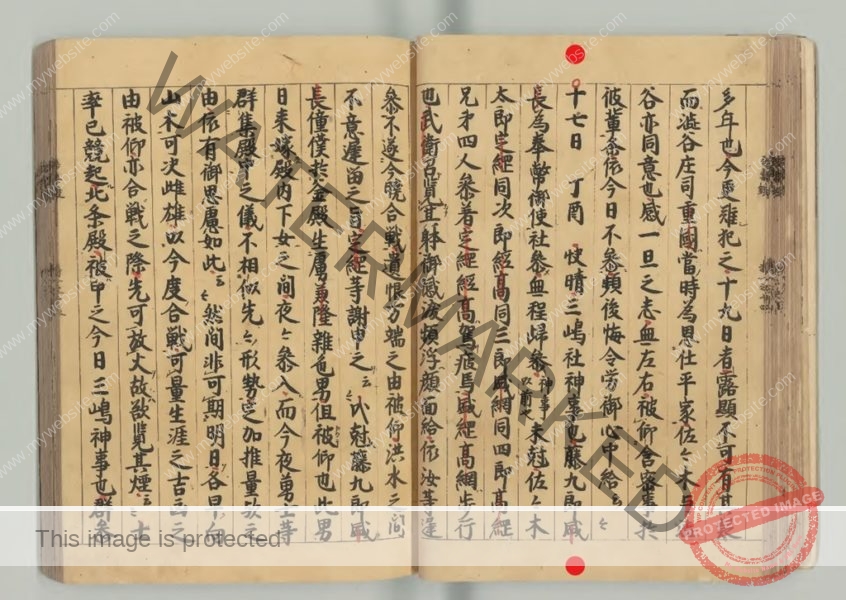
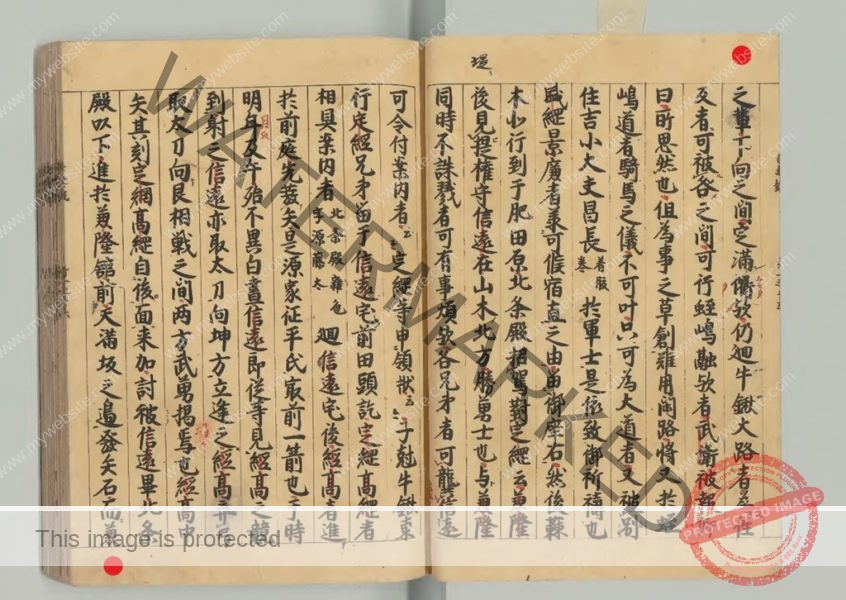
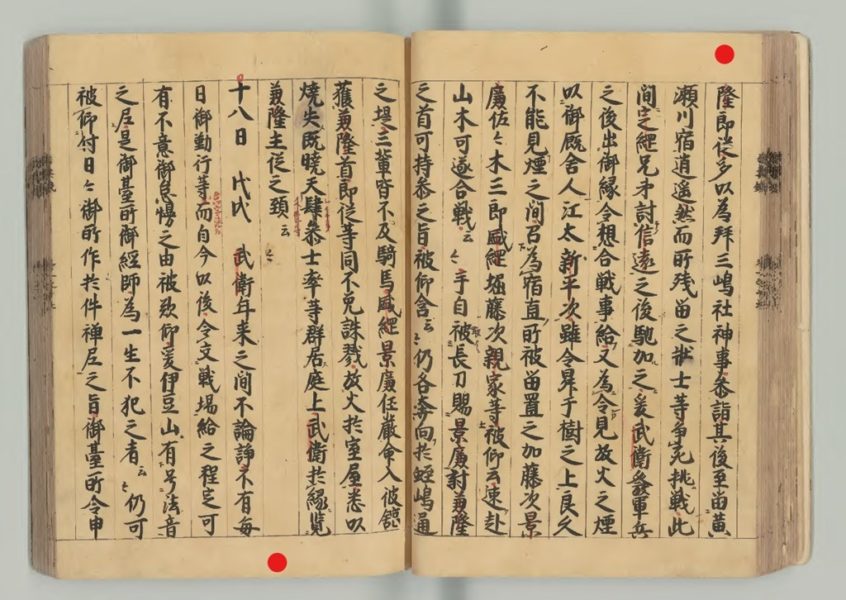
"Azuma Kagami" Bunji 4th year (1188) The first "nisho mode" written in the article of the New Year's Day 20
Visit to "Izu province running yu gongen (Izuyama shrine)" and "Sagami province Hakone Gongen (Hakone Shrine)" where Minamoto Yoritomo-ko started, and visit to Mishima Taisha shrine is called "nisho mode".
It is said that the name of "nisho mode" took two of the former, both
of which are "God and Buddha" related to Yoritomo. Since then, the kamakura shogun shogun has held almost a new year's annual event through the Kamakura Shogunate.
Bunji 4th year (1188) New Year's Day is written about the Shinto ritual of "nisho mode" below summary
1188 New Year's Day 16
Mr. Yoritomo visited Tsuruoka Hachimangu Shrine, and after returning to the Imperial Palace, he started bathing at Shojin Kiyoshisai in two places.1188 New Year's Day
The departure in two places approached, and I ordered it again today though it ordered in advance to guard the mountain road to the country imperial people such as Kai Izu Suruga etc.
That's because you're especially cautious because you still don't know where Yoshitsune is.20th Of New Year's Day,1188
Yoritomo left Kamakura and visited Izuyama Gongen Hakone Gongen Mishima Taisha Shrine.
Bushu 參 Junshu Genshin Ōo Kamiso Nitta Kurato Satomi Kanjin Tokukawa Saburo, etc.
Goro Izawa Mijiro Koyama's attendants were 300 cavalry.
It is said that as a person in charge of Miura Sukeyoshisumi, he made a ukibashi (Funabashi) on the Sagami River.
[Reference to the original text] National Archives Digital Archives [Azuma Mirror] Jijo 04 Manuscript Muromachi [former kurashi] Autumn Leaves Yama Bunko
https://www.digital.archives.go.jp/DAS/meta/listPhoto?LANG=default&BID=F1000000000000047829&ID=&TYPE=&NO=
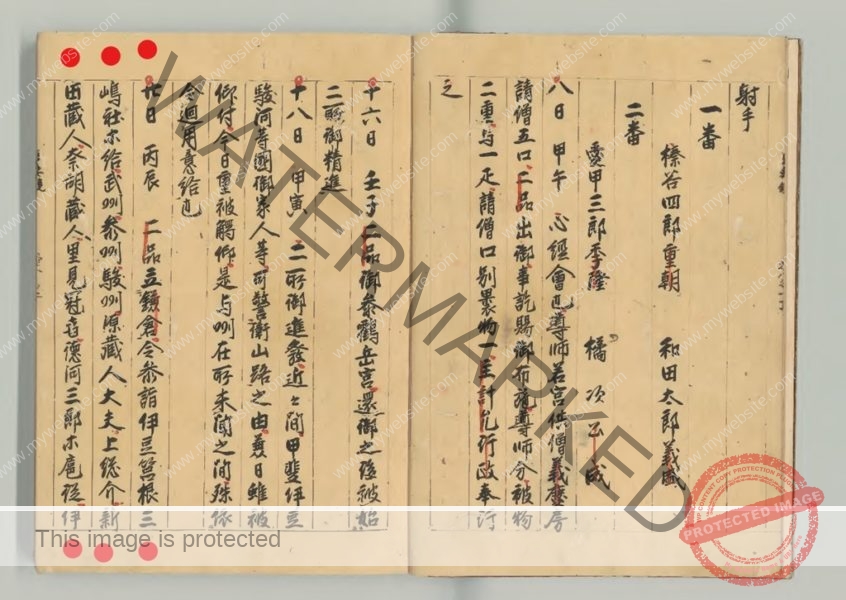
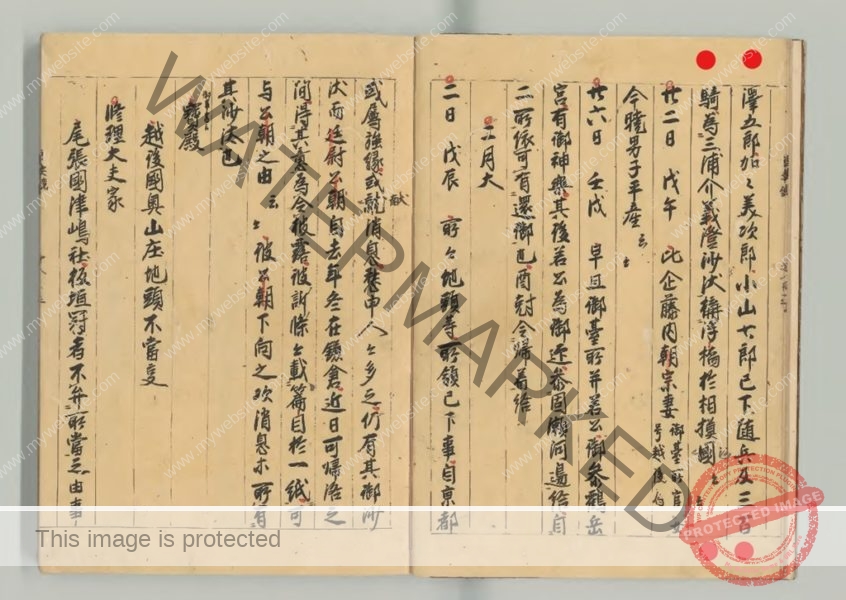
As Izu Kuni Ichinomiya, he had been revered by the Imperial Court as a god responsible for the eruption and island activities of the Izu Islands for a long time.
"hai" (90 degree bow) to Mishima Taisha (mishima taisha)

Please see the article of Ikonabi 咩 Mei Shrine (Shirahama Shrine) which is said to be a former shrine.

